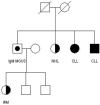Familial chronic lymphocytic leukemia
- PMID: 20389242
- PMCID: PMC2891437
- DOI: 10.1097/MOH.0b013e328338cd99
Familial chronic lymphocytic leukemia
Abstract
Purpose of review: Families with multiple individuals affected with chronic lymphocytic leukemia (CLL) and other related B-cell tumors have been described in the literature and strong familial aggregation has been seen in population studies. However, predisposing germline mutations have not been identified. We will discuss the spectrum of conditions associated with CLL in families and the advances in identifying the underlying susceptibility genes.
Recent findings: Familial CLL does not appear to differ substantially from sporadic CLL in terms of prognostic markers and clinical outcome, although it may be associated with more indolent disease. The precursor condition, monoclonal B-cell lymphocytosis, also aggregates in CLL families. Linkage studies have been conducted in high-risk CLL families to screen the whole genome for susceptibility loci but no gene mutations have yet been identified by this method. Association studies of candidate genes have implicated several genes as being important in CLL but more studies are needed. Results from whole-genome association studies are promising.
Summary: The ability to conduct large-scale genomic studies in unrelated CLL patients and in high-risk CLL families will play an important role in detecting susceptibility genes for CLL over the next few years and thereby help to delineate causal pathways.
Figures


References
-
- Jemal A, Siegel R, Ward E, Hao Y, Xu J, Thun MJ. Cancer statistics, 2009. CA Cancer J Clin. 2009;59:225–249. - PubMed
-
- Horner MJ, Ries LAG, Krapcho M, et al. SEER Cancer Statistics Review, 1975–2006. National Cancer Institute; Bethesda, MD: 2009.
-
- Linet MS, Schubauer-Berigan MK, Weisenburger DD, et al. Chronic lymphocytic leukaemia: an overview of aetiology in light of recent developments in classification and pathogenesis. Br J Haematol. 2007;139:672–686. - PubMed
-
- Houlston RS, Sellick G, Yuille M, Matutes E, Catovsky D. Causation of chronic lymphocytic leukemia--insights from familial disease. Leuk Res. 2003;27:871–876. - PubMed
Publication types
MeSH terms
Grants and funding
LinkOut - more resources
Full Text Sources
Medical
Research Materials

